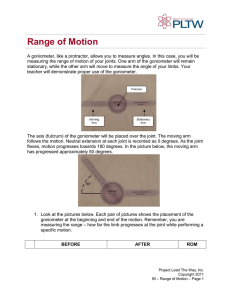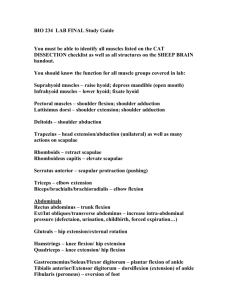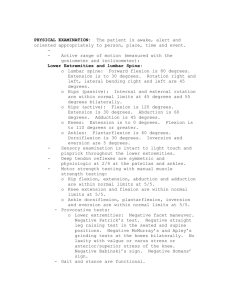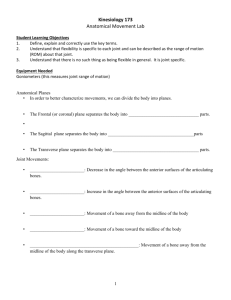Flexibility Assessment Lab
advertisement
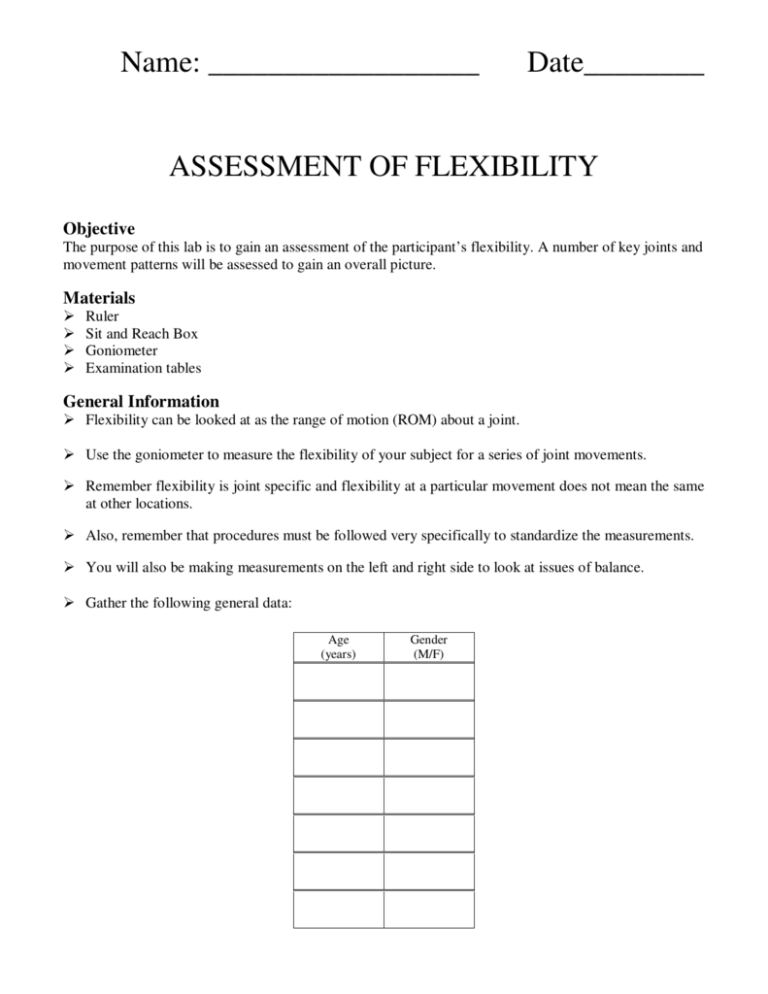
Name: __________________ Date________ ASSESSMENT OF FLEXIBILITY Objective The purpose of this lab is to gain an assessment of the participant’s flexibility. A number of key joints and movement patterns will be assessed to gain an overall picture. Materials Ruler Sit and Reach Box Goniometer Examination tables General Information Flexibility can be looked at as the range of motion (ROM) about a joint. Use the goniometer to measure the flexibility of your subject for a series of joint movements. Remember flexibility is joint specific and flexibility at a particular movement does not mean the same at other locations. Also, remember that procedures must be followed very specifically to standardize the measurements. You will also be making measurements on the left and right side to look at issues of balance. Gather the following general data: Age (years) Gender (M/F) Goniometer Measurements With the goniometer you will be measuring the angle through which the participant can move at the particular joint. The goniometer has a central area or disc where the angles of movement (range of motion) are read. It has two arms: a stationary arm and a moving arm. The specific procedures you will follow are presented in the following tables. Basically, the goniometer is centred on the axis of rotation. The stationary arm is placed in the starting position and will not move as the participant moves through the range of motion. The moving arm starts in the same position as the stationary arm, but as the participant moves through the ROM it follows until no more movement is possible. The angle of movement from the stationary arm to the movement arm is read off the central disc and reported as the ROM. Be aware of the position the body is supposed to be in for movement and any stabilization issues. If you do not follow the instructions specifically you will not make the measurements correctly and may be misrepresenting the ROM. Have the participant warm-up before performing the flexibility tests. At this point go through the series of measurements below and record your findings in the result section. Record the following measurements on both the left and right side of the body: Joint Movement Shoulder abduction (º) Shoulder flexion (º) Shoulder extension (º) Shoulder rotation – lateral (º) Shoulder rotation – medial (º) Wrist flexion (º) Wrist extension (º) Knee flexion (º) Hip flexion (º) Hip extension (º) Ankle plantar flexion (º) Ankle dorsi flexion (º) Left Right Measurement Ranking (acceptable/unacceptable) Use the following table to determine if your measurements fall in the range that would be considered acceptable or unacceptable and report the outcome with your results above: Linear Measurements With a ruler, measuring stick, flexometer, or sit-and-reach box you will measure the distance moved in a linear sense. While the joint movement is angular for sum measurements it is easier to report the flexibility change as a distance moved from a starting position. Have the participant warm-up before performing the flexibility tests. Specific instructions are presented below for 4 linear flexibility measures. Participant stands and reaches over the shoulder and down the back with one arm. Back Scratch Test While with the other arm reaches up the back from the other side. Measure the distance from finger tips of one hand to the finger tips of the other hand. If the finger tips overlap measure the distance of overlap. Right is considered to be with the right hand reaching over the shoulder and down (Right Up). Remove your shoes for the test. Standard Trunk Flexion (picture below) Sit on the floor with legs fully extended and feet placed flat against the sit and reach box; the inner edge of the feet should be about 6 inches apart). Place hands side by side with arms extended and reach forward reaching as far forward as possible. While you are doing the movement tuck the head down and exhale throughout, keeping knees extended and hands together. When you have reached as far as possible hold the final position for 2 seconds. Do not allow a bouncing or jerking movement. Repeat the trial twice and record the maximum distance. Participant lies prone on the floor with hands behind head. Trunk Extension On command, participant lifts upper body up as high as possible, extending the back. Measurement is taken from the floor to the participant’s chin. Remove your shoes for the test. Sit on the floor with the hips, back, and head against a wall, the legs fully extended, and the bottom of the feet against the sit-andreach box. Place the hands one on top of the other, and reach forward as far as possible without letting the head and back come off the wall (the shoulders may be rounded as much as possible, but neither the head nor the back should come off the wall at this time). The tester can then slide the reach indicator on the sit-and-reach box until it touches the participant’s fingers. Modified Trunk Flexion The indicator must be firmly held in this position throughout the (or modified sittesting. and-reach) Now allow your head and back to come off the wall and reach forward three times. On the 3rd time stretching forward as far as possible on the indicator and holding the final position for at least 2 seconds. Be sure that during the test you keep the backs of the knees flat against the floor. Record the final number. Complete a 2nd trial as listed above and average the two scores and use as the final result. Compare your result to the appropriate gender based percentile rank table. Linear measurements: Joint Movement Back scratch (inches) Joint Movement Standard Trunk flexion (cm) Trunk extension (inches) Modified Trunk Flexion (or Sit-andreach) (cm) Left Up Trial #1 Right Up Trial #2 Measurement Ranking Average Measurement Ranking For each of the linear movements the tables below can be used to assess the measurement ranking. Report this outcome with the above results: Back Scratch Test Norms (inches of overlap) Men Women Right Up Left Up Right Up Left Up Classification High Performance Zone Good Fitness Zone 7+ 6 7+ 3–6 8+ 6–7 8+ 3–7 Marginal Zone Low Zone 4–5 <4 0–2 <0 4–5 <4 0–2 <0 Standard Trunk Flexion Trunk Extension Norms (inches from chin to floor) Men Women Classification High Performance Zone 23 + 15 + Good Fitness Zone 15 – 22 10 – 14 Marginal Zone 10 – 14 6–9 Low Zone < 10 <6 Percentile ranks for modified sit-and-reach test in men Percentile Rank Age Category ≤ 18 19 – 35 36 – 49 ≥ 50 in. cm in. cm in. cm in. cm 99 20.8 52.8 20.1 51.1 18.9 48.0 16.2 41.1 95 90 19.6 18.2 49.8 46.2 18.9 17.2 48.0 43.7 18.2 16.1 46.2 40.9 15.8 15.0 40.1 38.1 80 70 17.8 16.0 45.2 40.6 17.0 15.8 43.2 40.1 14.6 13.9 37.1 35.3 13.3 12.3 33.8 31.2 60 50 15.2 14.5 38.6 36.8 15.0 14.4 38.1 36.6 13.4 12.6 34.0 32.0 11.5 10.2 29.2 25.9 40 30 14.0 13.4 35.6 34.0 13.5 13.0 34.3 33.0 11.6 10.8 29.5 27.4 9.7 9.3 24.6 23.6 20 10 05 01 11.8 9.5 8.4 7.2 30.0 24.1 21.3 18.3 11.6 9.2 7.9 7.0 29.5 23.4 20.1 17.8 9.9 8.3 7.0 5.1 25.1 21.1 17.8 13.0 8.8 7.8 7.2 4.0 22.4 19.8 18.3 10.2 ≥ 70th Percentile = high physical fitness standard 60 – 70th Percentile = health fitness standard Percentile ranks for modified sit-and-reach test in women Percentile Rank 99 95 90 80 70 60 50 40 30 20 10 05 01 Age Category ≤ 18 19 – 35 36 – 49 ≥ 50 in. cm in. cm in. cm in. cm 22.6 19.5 18.7 17.8 16.5 16.0 15.2 14.5 13.7 12.6 11.4 9.4 6.5 57.4 49.5 47.5 45.2 41.9 40.6 38.6 36.8 34.8 32.0 29.0 23.9 16.5 21.0 19.3 17.9 16.7 16.2 15.8 14.8 14.5 13.7 12.6 10.1 8.1 2.6 53.3 49.0 45.5 42.4 41.1 40.1 37.6 36.8 34.8 32.0 25.7 20.6 6.6 19.8 19.2 17.4 16.2 15.2 14.5 13.5 12.8 12.2 11.0 9.7 8.5 2.0 50.3 48.8 44.2 41.1 38.6 36.8 34.3 32.5 31.0 27.9 24.6 21.6 5.1 17.2 15.7 15.0 14.2 13.6 12.3 11.1 10.1 9.2 8.3 7.5 3.7 1.5 43.7 39.9 38.1 36.1 34.5 31.2 28.2 25.7 23.4 21.1 19.0 9.4 3.8 ≥ 70th Percentile = high physical fitness standard 60 – 70th Percentile = health fitness standard Analysis and Conclusion 1. What type of stretching is preferable for increasing flexibility? 2. Is stretching indicated as part of the warm-up for all sports? 3. What type of stretching is better for warming up before a performance? 4. Why is stretching more important after a long run? 5. Identify a sport and create a list of some five dynamic stretches specific to that sport. 6. Discuss the relative flexibility of your athlete and indicate where improvements are needed based on sport requirements.
